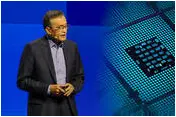Intel Cutting Cutting Edge Node Funds Would Mean No More Moore’s Law
Intel chief executive Lip-Bu Tan has warned that he may pull investment from Intel’s leading-edge 14A semiconductor process node unless “a meaningful external customer” can guarantee profits – a move which may finally spell the end of the chipmaker’s loyal adherence to Moore’s Law.
“Our external foundry strategy has always been rooted in the economic reality of semiconductor manufacturing,” Tan told listeners during the company’s Q2 2025 earnings call late last week. “Up to and through Intel 18A, we could generate a reasonable return on our investments with only Intel products. The increase in capital costs at Intel 14A make it clear [however] that we need both Intel products and a meaningful external customer to drive acceptable returns on our deployed capital. And I will only invest when I’m confident those returns exist.”
It’s an admission for which Intel had already offered advanced warning: back in May chief financial officer David Zinsner said: “I think we do need to see more external volume come from 14A versus 18A” – but Tan’s comment moves beyond a desire for external customers to a hard requirement, without which Intel may pull funding from its leading-edge process node development.
If that came to pass, it would potentially spell the end of Intel’s ability to follow Moore’s Law – the observation turned must-hit target made by Intel co-founder and pre-teen explosives enthusiast Gordon Moore, in an article for Electronics magazine written while still the director of research and development at Fairchild Semiconductor: “the complexity for minimum component costs has increased at a rate of roughly a factor of two per year.” This was revised a decade later to a prediction of a doubling in component count every two years.
At the time of Moore’s original observation, a leading-edge part had a few thousand transistors at most; today, the most powerful mainstream processors are exceeding a hundred billion transistors – and the only reason they’re not the size of football fields is that chip foundries have been shrinking feature sizes to cram more transistors into each part.
Each time a fab launches a new process node, there is concern that the ongoing shrinkage can’t continue. Today’s single-digit-nanometer nodes, two orders of magnitude smaller than when Intel was celebrating its first 0.13 micron (130nm) parts, require eye-wateringly expensive lithographic equipment based on extreme ultraviolet technology, like the “High NA” devices from Dutch photolithographic giant ASML. Even then, the laws of physics make actually producing leading-edge parts an increasing challenge – one with which Intel, the company that gave the world the first microprocessor, is struggling.
Former chief executive Pat Gelsinger led Intel on a vision quest to expand third-party use of its fabrication facilities, as a means of spreading the ever-growing cost of new fabrication equipment more widely. Four years into his reign and before reaching the end of his five-year plan he was gone, with successor Lip-Bu Tan taking a scythe to the company’s bottom line with product cancellations, mass layoffs, and the decision to turn its foundry business into an independent subsidiary.
The spin-out comes as Intel, ironically enough, increases its reliance on third-party manufacturers who have been more successful in their move to leading-edge process nodes – primarily Taiwan Semiconductor (TSMC), also the favourite of rival AMD since it too divested itself of manufacturing capabilities. It also followed the cancellation of Intel 20A, a larger and correspondingly lower-cost node which was to precede Intel 18A but which the company was unable to get off the ground.
Should Intel fail to find an external customer with deep enough pockets to balance the books, and should Tan deliver on his threat to pull funding, it could spell the end of Intel’s constant chasing of Moore’s Law – but the death of Moore’s Law has been predicted before in 2009, 2011, 2012, 2013, and so on. It has yet to come to pass.
Intel abandoning investment in and development of leading-edge nodes in favour of outsourced production and larger established nodes would mark the end of an era, undoubtedly, but also an opportunity for fab rivals like TSMC and GlobalFoundries to do what Intel couldn’t and keep the trend on-track.
Intel responded to our request for comment by pointing to Tan’s insistence that the company is “committed to the foundry business.” ®
A considerable amount of time and effort goes into maintaining this website, creating backend automation and creating new features and content for you to make actionable intelligence decisions. Everyone that supports the site helps enable new functionality.
If you like the site, please support us on “Patreon” or “Buy Me A Coffee” using the buttons below
To keep up to date follow us on the below channels.




![Cobalt Strike Beacon Detected - 140[.]143[.]132[.]170:80 6 Cobalt-Strike](https://www.redpacketsecurity.com/wp-content/uploads/2021/11/Cobalt-Strike-300x201.jpg)
